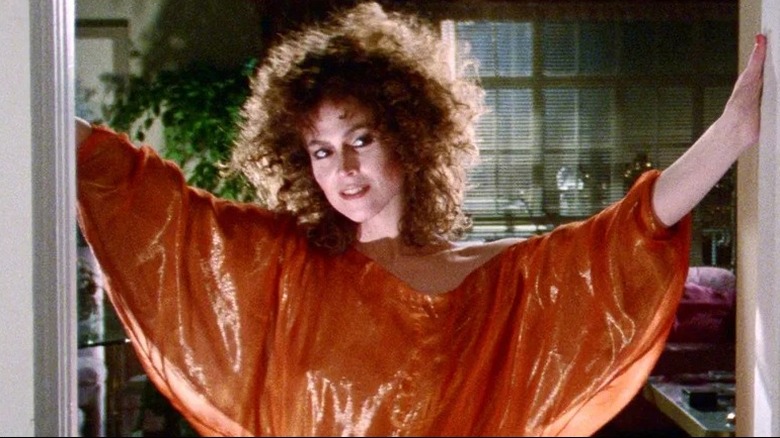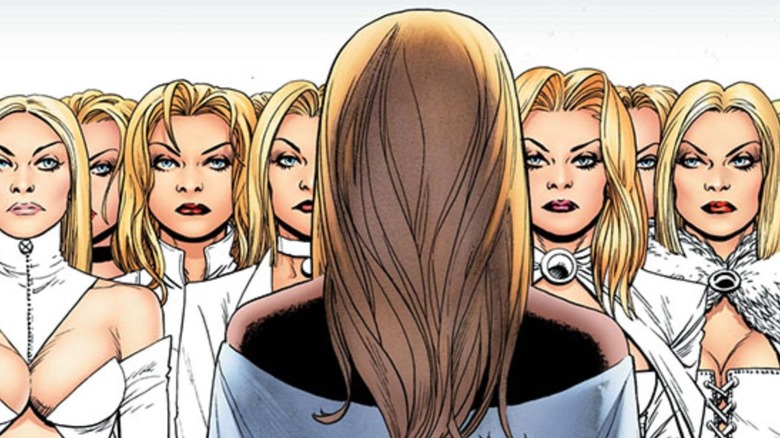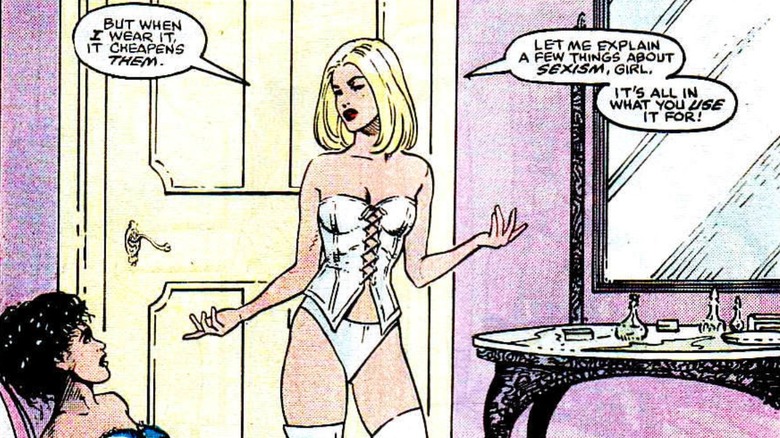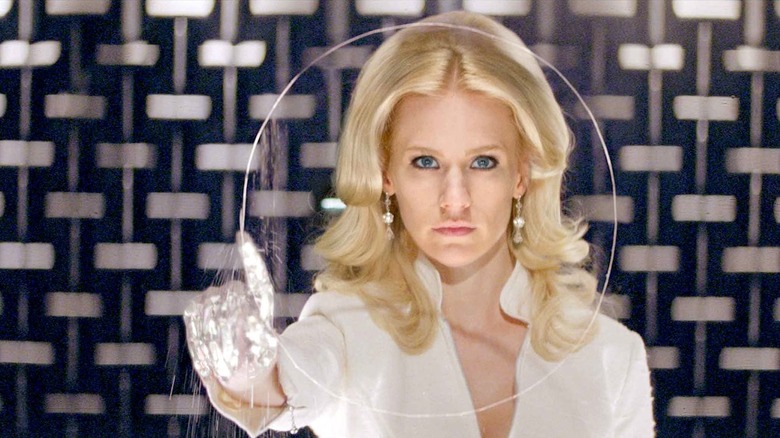Sigourney Weaver Almost Played A Classic X-Men Character In The Last Stand
20th Century Fox's Studios' third "X-Men" film changed a lot due to the departure of director Bryan Singer, who was replaced by Brett Ratner (the franchise trading one accused sex offender for another).
Part of Singer's unrealized plans for this trilogy capper, ultimately subtitled "The Last Stand," was to introduce a famous comic character played by an A-List star. Screenwriter Dan Harris, who left the project to work on "Superman Returns" with Singer, revealed back in 2004:
"We were going to do 'X-Men 3' for a little while and our big secret or coup was — and it's not going to happen so it's OK — we wanted to have a character that was Emma Frost, a famous 'X-Men' character. She's called the White Queen. We were going to ask Sigourney [Weaver] to be it. She was an empath in our version of the movie, which means she could control people's emotions."
"The Last Stand" adapts "The Dark Phoenix Saga," where Emma was introduced in the comics. So, I understand the impulse to bring her on board. Ratner's "The Last Stand" introduced a boatload of new Mutant characters (doing justice to few of them), but Emma wasn't among their numbers.
Weaver is one of the best actors alive, but she strikes me as an odd choice for Emma Frost. Her version would've undoubtedly been a steep departure from the comics — not that the "X-Men" movies have ever been shy about deviating from their source material.
Who is Emma Frost?
Emma debuted as a villain in "Uncanny X-Men" issue #129 (written by Chris Claremont, art by John Byrne). She's the telepathic "White Queen" of the Hellfire Club, an alliance of rich and evil mutants with a thing for 18th-century clothes. Emma also runs the Massachusetts Academy — like Xavier's School, but evil. Both she and the X-Men try to recruit young Kitty Pryde to their schools, so Emma has the X-Men captured.
Emma, referred to mostly as the White Queen, is the villain for the first chunk of "The Dark Phoenix Saga." Byrne's cover for issue #131 features her hovering menacingly over the heroes. After her defeat, the rest of the Club takes over her antagonist role, but of their members, Emma became the most popular character. I can imagine one reason why.
As you might glean from the corset, stockings, and high heels, Emma is another example of Claremont's blatantly obvious fetish for dominatrices; she can control men's wills even without her telepathy. Claremont and Byrne modeled their White Queen on Dame Diana Rigg. Specifically, the BDSM costume she wore as Emma Peel in "A Touch of Brimstone," an episode of the British spy show "The Avengers" (no relation to the Marvel version).
Is Emma Frost just a fetish pin-up? On the surface, maybe — which is the way she likes it.
DominatriX
Sexuality remains a core part of Emma's character, but her agency is rooted in that, not in spite of it. Raised in an abusive household, Emma Frost clawed her way to power, respect, and self-confidence by learning to play the games of men. Take the backup story "Classic X-Men #34" (written by Ann Nocenti, art by John Bolton), where she chastises a Hellfire Club worker for being embarrassed about wearing lingerie. Deciding to give the girl a "lesson" in sexism, Emma declares:
"My clothes are my battle armor! I dress to go to war! My looks and body are weapons on par with a man's fist."
Emma is someone who twists oppressive systems to work for her, not someone who tears injustice down like other X-Men. On the "X-Men" podcast "Cerebro," host Connor Goldsmith describes Emma as the third vision for mutantkind's future between Professor X's dreams of integration and Magneto's separatism. Emma is a minority capitalist, someone who believes in the power of and for the individual. I'll admit this read has colored my perception of the character since. It also tracks with recent comics, where Emma becomes president of the Hellfire Trading Company (the first mutant-owned pharmaceutical corporation).
The obvious casting for Emma seems like a blonde bombshell. Weaver's brunette hair is easily solved (comic Emma herself is a bottle blonde, while Weaver went blonde in "Galaxy Quest"), but her age (mid-50s in the 2000s) makes this choice more confusing. Was the plan to downplay Emma's sexuality and play up her allure as pure mind control? If so, that's not really Emma Frost. Then again, there's nothing that precludes a middle-aged woman from being sexy; showing how Emma keeps her "weapons" sharp as they age could even be a compelling spin on her character.
Teaching the good guys
Emma Frost isn't only a seductress, CEO, superhero, or supervillain; she's also a teacher. In "Uncanny X-Men" issues #151-152, she tries to lure Kitty Pryde away from the X-Men to her own tutelage. Her students at the Massachusetts Academy make up a team called the Hellions, an evil counterpart to the New Mutants. With her inclination for teaching, it's no surprise Emma eventually left the Hellfire Club and became an instructor at Xavier's School for Gifted Youngsters.
Emma was part of the cast of the 1990s comic "Generation X" (which was adapted into a TV movie starring Finola Hughes in 1996), but she only became a core X-Men teammate in the 21st century. Specifically, she took the spotlight in Grant Morrison's "New X-Men." Morrison, who has experimented with drag (read their book "Supergods") and has since come out as non-binary, was naturally drawn to a character who so loudly performs femininity.
Their run helped create Emma Frost as modern readers know her. For one, she got a "secondary mutation" — the ability to turn her skin into diamond. She also fell in love with Scott Summers/Cyclops (they had a psychic love affair), and their relationship has endured since.
Even so, Emma's never lost her cynicism. See "Astonishing X-Men" #1 (Joss Whedon and John Cassaday), where as part of a class orientation, she plays a hologram of a Sentinel attack. The first lesson for mutant students? Humans will always hate and fear them.
Emma Frost onscreen
Emma Frost remains one of the numerous X-Men characters not done justice by the movies (see anyone not named Professor X, Magneto, Wolverine, Beast, or Nightcrawler). She first appeared in "X-Men Origins: Wolverine" played by Tahyna Tozzi, but that movie (and the character) were all but dropped from continuity. January Jones played a more traditional Emma Frost in "X-Men: First Class." Unfortunately, the performance was directed wrong; flat and cold, not flamboyant and powerful. Magneto nearly cracking her diamond form by manipulating a metal bedpost around her alludes to Emma's bondage beginnings in all the wrong ways.
Emma was also wastefully killed off in the sequel, "Days of Future Past," so no journey to heroism for her. Speaking of waste, Sigourney Weaver did eventually get a Marvel role — Alexandra, the immortal leader of the Hand and villain of "The Defenders" — but it was a thankless part without a single memorable moment.
Assuming Marvel Studios manages to get to the X-Men before superhero fatigue sinks the Marvel Cinematic Universe, is there room for the fifth time to be Emma's charm? Sydney Sweeney looks the part, but she's already webbed up in a Marvel movie as Spider-Woman. Lady Gaga also has the sort of ostentatious command of the screen that Emma needs too. Then again, the MCU is the most sexless movie franchise around, a place where Emma might find her battle armor and weapons of war to be no use.




